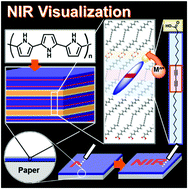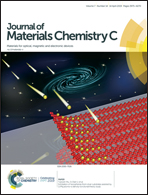Quantitative detection of near-infrared (NIR) light using organic layered composites†
Abstract
Quantitative detection of external stimuli, such as light, heat, and force, is an important challenge for sensing materials. Near-infrared (NIR) light is used in a variety of fields, such as biological, physical, medical, and engineering applications. Visualization and quantitative detection of invisible NIR are significant for its safe use. Here we fabricate a paper-based device coated with polypyrrole (PPy) and layered polydiacetylene (PDA). As PPy induces evolution of heat with irradiation of NIR, the effective conjugation length of the layered PDA is changed by the dynamic structure changed through the heat conduction. The visible color change from blue to red proceeds on the paper device. The red-color intensity has a relationship with the irradiation power of NIR. These facts suggest that the irradiation time and power of NIR are quantified by the color. Moreover, the results indicate that layered PDA can be applied to the quantification of external stimuli through conversion from the desired stimulus to the detectable one.



 Please wait while we load your content...
Please wait while we load your content...